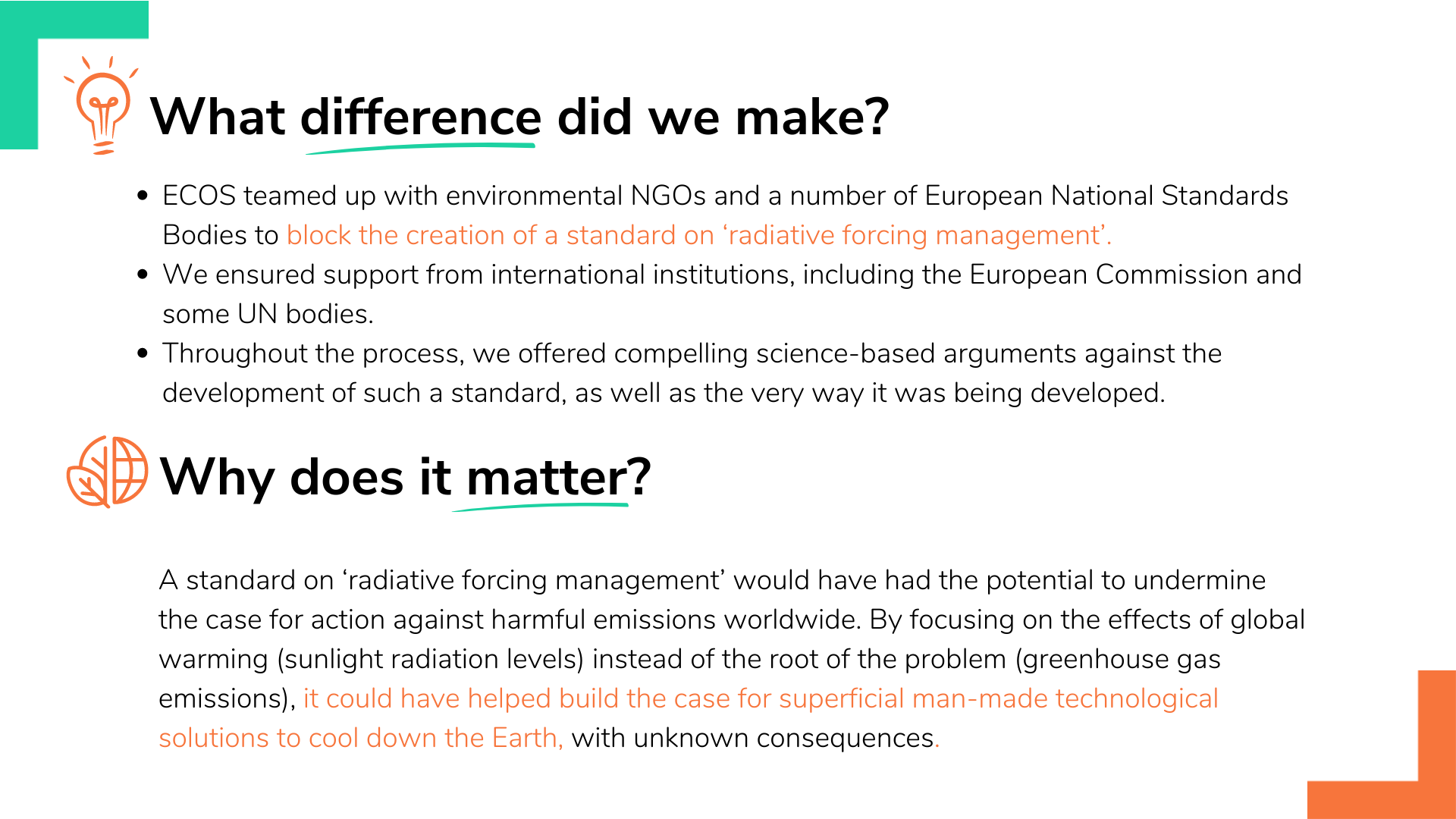Defending the science behind global warming accounting
In 2021, ECOS made sure that an ISO standard on ‘radiative forcing management’ did not see the light of day. If published, the standard could have become a new commonly-agreed way of measuring climate change – an alternative to greenhouse gas emissions (GHG), the most common reference today. The standard could have been used to challenge the scientific arguments pointing to human influence on global warming.

In 2019, the American National Standards Institute (ANSI) proposed that the international body ISO create a standard on ‘radiative forcing management’. It was intended to offer internationally-agreed common ‘guidance for the quantification and reporting of radiative forcing-based climate footprints and mitigation efforts’. In other words, the standard would have become a new official way of measuring climate change, which could have been used as an alternative to greenhouse gas emissions (GHG), the most common reference today.
Confusing and dangerous
The implications are significant: such a standard, relying on inconclusive and uncertain metrics, could have helped question the science behind global warming. Why? ‘Radiative forcing’ measures the impact of the incoming solar radiations on Earth. The impact of these radiations typically depends on:
- emissions of greenhouse gases (which increase the impact of solar radiations),
- emissions of climate coolants, such as sulfur (blocking solar radiations and therefore decreasing the impact of the Sun on the Earth’s temperature),
- colour of the Earth’s surface at a given place (darker surfaces absorb radiation and therefore increase the impact of solar radiation, while brighter surfaces reflect sunlight).
If developed, the standard might have enabled the use of ‘radiactive forcing’ instead of GHG emissions to measure our impact on climate change. While a sizable amount of evidence backs the scientific soundness of GHG, some components of radiactive forcing are simply impossible to measure accurately.
Geoengineering is not a solution
What is worse, the general use of ‘radiactive forcing’ could have been used by actors promoting ‘geoengineering’ initiatives, who try to come up with ideas to artificially reduce the planet’s temperature or offset greenhouse gas emissions, delaying the phase-out of fossil fuels. For example, researchers at Harvard University are testing the effects of releasing dust on the atmosphere on a large scale so that sunlight is dimmed and solar radiation on the Earth is reduced.
Another geoengineering technique is to intentionally emit climate coolants. In 2019, a study published in the peer-reviewed journal Nature Climate Change suggested injecting sulphur dioxide into the atmosphere. However, scientists point to the unknown potential implications of doing so on a global scale.
Such man-made solutions have unknown implications for the planet and do little more than divert attention from the need to stop global warming emissions altogether to prevent a climate breakdown.
How to stop a harmful standard
The standardisation request put forward by ANSI was at first meant to become a ‘prescriptive international standard’, a document with the highest level of authority within ISO, offering very precise instructions on how it should be followed, with very little room for flexibility.
We could not let this happen. We decided to create a multi-stakeholder coalition against the standard, which included representatives from National Standards Bodies, environmental NGOs, the European Commission and others. We repeatedly made our case at ISO technical committee meetings, as well as public events held by prominent international organisations, including UN bodies.
Hearing our concerns, ISO decided to downgrade the document to a Technical Report – corresponding to nothing more than a non-binding informative document.
This was a win, but it was not enough: we wanted the standard to be completely scrapped. To build our case, we documented and exposed the flaws in the development of the Technical Report. We argued that the science behind radiative forcing is not mature enough for it to be standardised.
Finally, things started to shift in our favour: we gathered support within the ISO technical group developing the Technical Report. As a result, ISO decided to completely cancel the development of any kind of agreed technical specifications for ‘radiactive forcing management’.
Away from the spotlight, ECOS ensured a vital win for science – and the planet.


